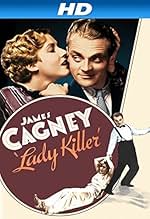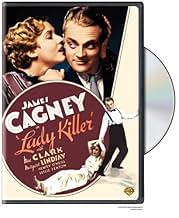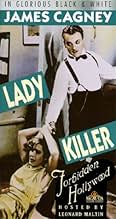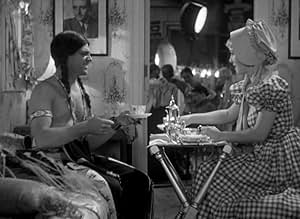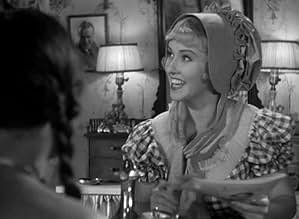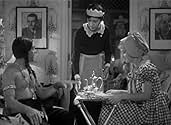CALIFICACIÓN DE IMDb
7.0/10
2.1 k
TU CALIFICACIÓN
Un antiguo gángster triunfa en Hollywood, pero su antigua vida lo alcanza.Un antiguo gángster triunfa en Hollywood, pero su antigua vida lo alcanza.Un antiguo gángster triunfa en Hollywood, pero su antigua vida lo alcanza.
- Dirección
- Guionistas
- Elenco
- Premios
- 1 premio ganado en total
Douglass Dumbrille
- Spade Maddock
- (as Douglas Dumbrille)
William B. Davidson
- Director Williams
- (as William Davidson)
Lowden Adams
- Lois' Butler
- (sin créditos)
Luis Alberni
- Director
- (sin créditos)
Joseph Belmont
- Monkey Party Guest
- (sin créditos)
Brooks Benedict
- Charlie - the Fence
- (sin créditos)
Harry Beresford
- Dr. Crane
- (sin créditos)
Opiniones destacadas
If you like James Cagney, and I sure do, you'll love this comedy melodrama from the pre-code years at Warner Brothers. Cagney portrays a cheap hoodlum who falls in with a gang of petty con artists, gets wrapped on the knucklesl by the long arm of the law, and winds up becoming a movie matinee idol. It's fun all the way, with enough wise-cracking dialogue, rapid action, car chases, gunfire, and double-dealing to satisfy any fan of the early gangster films, yet it's a lively, tongue-in-cheek comedy from start to finish. Enjoy!
Look out, world! Jimmy Cagney's coming to Hollywood and whether they use bullets or make-up the con artists haven't got a chance, in this raucous send-up featuring a New York crime boss who lands himself where the real action is – on a theater marquee.
Cagney is a wise guy named Dan Quigley who can't make it as a movie usher, so he raises his sights from lavatory dice games to breaking into rich folks' homes with the help of a nasty gang. When that goes bad and the gang leaves him flat, Quigley finds a new line in Hollywood, first as an extra, soon after as a "Famous He-Man of the Screen." But what will happen when the old gang shows up for a piece of the action?
The marquee in lights near the start of the film advertises someone called "The Prince Of Pep." He might as well be Cagney in this streamlined star vehicle, written entirely to showcase his fast patter and easy charm. Cagney's so good they don't even bother to build a coherent film around his character, and it hardly matters.
If you want to see a great Cagney film, there are perhaps a couple dozen better candidates. But if you want to see why the guy clicked so hard in the days of early sound, and still packs a punch 80 years later, this should be on your short list.
Cagney's lines here are priceless. To a dog being held by a theater manager who just fired him: "Listen, Fido, this guy's got a wooden leg. Try it sometime!"
To a group of card sharps who just cleaned him out: "I think I'll stick to checkers."
To the same group, after he's figured out their scam: "You kick back with my fifty bucks, or I'll fold your joint like an accordion!"
Just seconds later, he proposes a partnership. "You got a sweet racket here. Maybe I can show you a few new wrinkles."
"Lady Killer" was made just before the Hays Code was seriously enforced, which makes for interesting viewing. Reviewers here have already pointed out a scene when we see Quigley sneak Mae Clarke's character Myra a peck on the breast. The film takes even greater advantage of the liberal mores then still in effect by letting Quigley get away with his crimes. Sure, he goes straight, sort of, but only because he finds a better racket than potentially homicidal B&Es. There's no moment of Quigley coming to regret his wicked past, as censors would have required just months later.
That makes for a more entertaining Cagney vehicle, but a somewhat disjointed film. Director Roy Del Ruth keeps things moving quick, but in odd directions in tone, turning "Lady Killer" from a semi-serious gangster story to a genially goofy Hollywood satire. In his DVD commentary, Drew Casper calls "Lady Killer" a "shyster satire." It might also be called a "crooked comedy;" no one is on the level, whichever side of the law they're on.
So in Hollywood, we see Quigley break big after really slugging an extra in a mock prison break scene, and further his path toward stardom by faking fan letters. It's shallow stuff, but fun, especially as it all plays so fast. Other than the star, pacing is "Lady Killer's" ace in the hole.
Clarke should have graduated from the grapefruit league with this performance. She and Cagney resume their fireworks from "Public Enemy," this time with even more outrageous stunts, but Clarke, here the first- billed female, does wise work making sure we enjoy her comeuppance. Even her catty asides to Cagney, or the way she shamelessly plays with her hair while shaking him down for (more) dough, is on par with Barbara Stanwyck's star-making wickedness.
But make no mistake, "Lady Killer" is Cagney's baby, and he makes it work, despite the tone shifts and the odd title (Quigley's not a killer himself, and doesn't play with women's affections). You root for the guy despite his crookedness, and that's all that matters in the end.
Cagney is a wise guy named Dan Quigley who can't make it as a movie usher, so he raises his sights from lavatory dice games to breaking into rich folks' homes with the help of a nasty gang. When that goes bad and the gang leaves him flat, Quigley finds a new line in Hollywood, first as an extra, soon after as a "Famous He-Man of the Screen." But what will happen when the old gang shows up for a piece of the action?
The marquee in lights near the start of the film advertises someone called "The Prince Of Pep." He might as well be Cagney in this streamlined star vehicle, written entirely to showcase his fast patter and easy charm. Cagney's so good they don't even bother to build a coherent film around his character, and it hardly matters.
If you want to see a great Cagney film, there are perhaps a couple dozen better candidates. But if you want to see why the guy clicked so hard in the days of early sound, and still packs a punch 80 years later, this should be on your short list.
Cagney's lines here are priceless. To a dog being held by a theater manager who just fired him: "Listen, Fido, this guy's got a wooden leg. Try it sometime!"
To a group of card sharps who just cleaned him out: "I think I'll stick to checkers."
To the same group, after he's figured out their scam: "You kick back with my fifty bucks, or I'll fold your joint like an accordion!"
Just seconds later, he proposes a partnership. "You got a sweet racket here. Maybe I can show you a few new wrinkles."
"Lady Killer" was made just before the Hays Code was seriously enforced, which makes for interesting viewing. Reviewers here have already pointed out a scene when we see Quigley sneak Mae Clarke's character Myra a peck on the breast. The film takes even greater advantage of the liberal mores then still in effect by letting Quigley get away with his crimes. Sure, he goes straight, sort of, but only because he finds a better racket than potentially homicidal B&Es. There's no moment of Quigley coming to regret his wicked past, as censors would have required just months later.
That makes for a more entertaining Cagney vehicle, but a somewhat disjointed film. Director Roy Del Ruth keeps things moving quick, but in odd directions in tone, turning "Lady Killer" from a semi-serious gangster story to a genially goofy Hollywood satire. In his DVD commentary, Drew Casper calls "Lady Killer" a "shyster satire." It might also be called a "crooked comedy;" no one is on the level, whichever side of the law they're on.
So in Hollywood, we see Quigley break big after really slugging an extra in a mock prison break scene, and further his path toward stardom by faking fan letters. It's shallow stuff, but fun, especially as it all plays so fast. Other than the star, pacing is "Lady Killer's" ace in the hole.
Clarke should have graduated from the grapefruit league with this performance. She and Cagney resume their fireworks from "Public Enemy," this time with even more outrageous stunts, but Clarke, here the first- billed female, does wise work making sure we enjoy her comeuppance. Even her catty asides to Cagney, or the way she shamelessly plays with her hair while shaking him down for (more) dough, is on par with Barbara Stanwyck's star-making wickedness.
But make no mistake, "Lady Killer" is Cagney's baby, and he makes it work, despite the tone shifts and the odd title (Quigley's not a killer himself, and doesn't play with women's affections). You root for the guy despite his crookedness, and that's all that matters in the end.
Lady Killer (1933)
*** (out of 4)
James Cagney plays a movie usher who gets fired and then gets mixed up with some gangster being led by Douglas Dumbrille and Margaret Lindsay. Soon a crime goes wrong so Cagney runs off to Hollywood where he starts work as an extra but quickly becomes a movie star. This is an enjoyable little comedy that works pretty well as a spoof of Hollywood and it gives Cagney a chance to make fun of his own image. Cagney is very good in his role, which once again shows him as a cocky, high tempered thug but there's also other moments including Cagney playing an Indian as well as showing off his comic side. Mae Clarke plays Cagney's love interest in Hollywood and the two are very good together with that infamous scene of Cagney dragging her across the floor by her hair. Both Lindsay and Dumbrille add nice support in their roles. One of the film's highlights is when Cagney orders two dozen monkeys to a party where they escape and cause all sorts of trouble. There's also plenty of nice gags aimed at Hollywood and directors. The film starts to run out of steam during the final act but if you're a fan of Cagney or films of this era then this is certainly worth checking out.
*** (out of 4)
James Cagney plays a movie usher who gets fired and then gets mixed up with some gangster being led by Douglas Dumbrille and Margaret Lindsay. Soon a crime goes wrong so Cagney runs off to Hollywood where he starts work as an extra but quickly becomes a movie star. This is an enjoyable little comedy that works pretty well as a spoof of Hollywood and it gives Cagney a chance to make fun of his own image. Cagney is very good in his role, which once again shows him as a cocky, high tempered thug but there's also other moments including Cagney playing an Indian as well as showing off his comic side. Mae Clarke plays Cagney's love interest in Hollywood and the two are very good together with that infamous scene of Cagney dragging her across the floor by her hair. Both Lindsay and Dumbrille add nice support in their roles. One of the film's highlights is when Cagney orders two dozen monkeys to a party where they escape and cause all sorts of trouble. There's also plenty of nice gags aimed at Hollywood and directors. The film starts to run out of steam during the final act but if you're a fan of Cagney or films of this era then this is certainly worth checking out.
Jimmy Cagney plays a gangster in this film. However, despite having seen him play such a role in countless other films, this one is unique and well worth seeing because it STILL dares to be different.
Cagney is a wanted man back East, so he gets the idea of going to the West Coast to hang out and wait for things to die down. However, once there he is discovered by Hollywood and stars in gangster films because he is "so natural and believable". Well, despite his very shady past, Cagney tries to go straight and likes the life of a star. However, old associates realize who he is and try to blackmail him.
The film is a light comedy that invigorates the standard gangster genre. For its uniqueness and excellent acting and writing, the film gets an 8.
Cagney is a wanted man back East, so he gets the idea of going to the West Coast to hang out and wait for things to die down. However, once there he is discovered by Hollywood and stars in gangster films because he is "so natural and believable". Well, despite his very shady past, Cagney tries to go straight and likes the life of a star. However, old associates realize who he is and try to blackmail him.
The film is a light comedy that invigorates the standard gangster genre. For its uniqueness and excellent acting and writing, the film gets an 8.
Lady Killer (1933)
I love these multi-part stories, where one set of scenes shifts to a whole new set, and then they eventually intertwine. And I also love movies that show the inside of Hollywood, with actual recreations of movie sets and movie shoots.
Lady Killer has both, and James Cagney, too. It's fast, furious, funny, and shot with a bright, glinting intelligence. Not quite a gangster film, it does have crime and some crooked thugs. And not quite a comedy, it pulls out quite a few laughs, mostly because Cagney is a card. There are two fabulous first ladies (and they naturally must view for our man), Mae Clark and Margaret Lindsay, and a slew of second men who hold up their characters with caricature.
In all, there is no Warner message here, except maybe the virtue can sometimes prevail. It's just a lot of great scenes, witty dialog, and a play of good guys against bad guys. Look for some stunning rain scenes in California (yeah, I know), and for a huge range of interior and exterior set ups, fairly elaborate for Warner Bros. budgets.
For Cagney fans, it's a riot to see him take on, briefly, a series of roles as Indian chief, Italian lover, and prisoner on work detail. The latter, of course, is close to the real roles that made him famous, and his role here is actually a little lighter than that, a bad guy who is all wisecracks and cheerfulness. Look for some insider jokes, like the poster (and mention) of the Edward G. Robinson film, and the movie ushers wearing hats all with the Warner Brothers logo on it.
Great stuff. I loved it even as I knew it wasn't quite a masterpiece. Oh, and the new (2010) Warner DVD is sparkling, a first rate print!
I love these multi-part stories, where one set of scenes shifts to a whole new set, and then they eventually intertwine. And I also love movies that show the inside of Hollywood, with actual recreations of movie sets and movie shoots.
Lady Killer has both, and James Cagney, too. It's fast, furious, funny, and shot with a bright, glinting intelligence. Not quite a gangster film, it does have crime and some crooked thugs. And not quite a comedy, it pulls out quite a few laughs, mostly because Cagney is a card. There are two fabulous first ladies (and they naturally must view for our man), Mae Clark and Margaret Lindsay, and a slew of second men who hold up their characters with caricature.
In all, there is no Warner message here, except maybe the virtue can sometimes prevail. It's just a lot of great scenes, witty dialog, and a play of good guys against bad guys. Look for some stunning rain scenes in California (yeah, I know), and for a huge range of interior and exterior set ups, fairly elaborate for Warner Bros. budgets.
For Cagney fans, it's a riot to see him take on, briefly, a series of roles as Indian chief, Italian lover, and prisoner on work detail. The latter, of course, is close to the real roles that made him famous, and his role here is actually a little lighter than that, a bad guy who is all wisecracks and cheerfulness. Look for some insider jokes, like the poster (and mention) of the Edward G. Robinson film, and the movie ushers wearing hats all with the Warner Brothers logo on it.
Great stuff. I loved it even as I knew it wasn't quite a masterpiece. Oh, and the new (2010) Warner DVD is sparkling, a first rate print!
¿Sabías que…?
- TriviaFor the scene when Dan Quigley hauls Myra Gale across the apartment floor by her hair and throws her out the door, James Cagney taught his co-star Mae Clarke an old stage trick. When Cagney grabbed hold of Clarke's hair (holding her by the top of her head), Clarke reached up and grabbed Cagney's wrist with both hands. This put her weight on Cagney's wrist, instead of on her hair. Clarke then held on to Cagney's wrist, screaming, as he dragged her across the room.
- ErroresAfter the robbery of the wealthy woman's home, the paper says a maid was struck and seriously injured, and later in Dan Quigley's office, they're still talking about a maid who screams. Later, when the guy who actually hit her comes back scared, he says the butler died.
The owner of the house where Dan was taken after the "car accident" was Mrs. Wilbur Marley. This was the house where the maid was "slugged". The butler who "croaked" was "on the Crosby job".
- Citas
Spade Maddock: [discussing diamond-studded Mrs. Marley at the gang's speakeasy] C'mere - take a gander at her.
Dan Quigley: [eyeing her through a peephole] Did you say "gander?" I wonder how she'd go for a goose.
- ConexionesFeatured in Hollywood: The Great Stars (1963)
- Bandas sonorasIsn't It Heavenly
(1933) (uncredited)
Music by Joseph Meyer
Lyrics by E.Y. Harburg
Played when Myra invites Dan into her apartment.
Selecciones populares
Inicia sesión para calificar y agrega a la lista de videos para obtener recomendaciones personalizadas
- How long is Lady Killer?Con tecnología de Alexa
Detalles
- Fecha de lanzamiento
- País de origen
- Idiomas
- También se conoce como
- The Finger Man
- Locaciones de filmación
- Hinman Hotel, 7th Street and Figueroa Street, Los Ángeles, California, Estados Unidos(The opening scene with the theater manager addressing his ushers in military formation is filmed on the rooftop of this hotel building)
- Productora
- Ver más créditos de la compañía en IMDbPro
- Tiempo de ejecución1 hora 16 minutos
- Color
- Mezcla de sonido
- Relación de aspecto
- 1.37 : 1
Contribuir a esta página
Sugiere una edición o agrega el contenido que falta

Principales brechas de datos
What is the Spanish language plot outline for Lady Killer (1933)?
Responda

